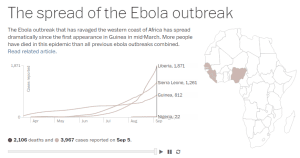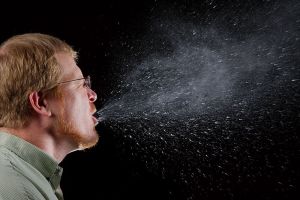Over 1,000 Children infected with suspected Human Enterovirus 68 (HEV68)
Over one thousand children in the Midwest have presented with symptoms of suspected Enterovirus 68, a rare, highly infectious virus that affects children more severely than adults, especially those under five years old and those with asthma. The infection starts with cold-like symptoms and then escalates quickly to a serious condition that complicates breathing.
 This outbreak was first reported in Colorado on Aug 18 and as of September 5th, one Colorado hospital has seen over nine hundred ER visits, and one hospital in Kansas City has seen over three hundred. The CDC has received assistance requests from ten states including Colorado, Kansas, Oklahoma, Missouri, Iowa, Illinois, Kentucky, Ohio, Georgia and North Carolina. Children returning to school during the season when the virus is most abundant has contributed to the outbreak, CDC officials told ABC News Chief Medical Editor Dr. Richard Besser.
This outbreak was first reported in Colorado on Aug 18 and as of September 5th, one Colorado hospital has seen over nine hundred ER visits, and one hospital in Kansas City has seen over three hundred. The CDC has received assistance requests from ten states including Colorado, Kansas, Oklahoma, Missouri, Iowa, Illinois, Kentucky, Ohio, Georgia and North Carolina. Children returning to school during the season when the virus is most abundant has contributed to the outbreak, CDC officials told ABC News Chief Medical Editor Dr. Richard Besser.
“”This is a very common time for outbreaks. Kids come back to school, they like to share things, they bring them home to their little brothers and sisters, and enteroviruses tend to occur in the summer,” Besser said. “But this one, this particular Enterovirus 68, is very rare and they have no idea why it showed up this year.”
Doctors expect the outbreak to become a nationwide problem. There is no cure or vaccine – parents should watch for wheezing and get immediate medical attention if they see difficulty breathing. Common infection control is also suggested, frequent hand washing for children and keeping them home if they show cold-like symptoms.
As discussed in these 2009 posts, big issues for this type of outbreak include Respirator Availability, Priority Access to Public  Resources, and the special treatment needs of Pediatric Cases,
California to Spray Orange Country Neighborhoods in the wake of West Nile Virus Deaths
West Nile virus (WNV) is most commonly transmitted to humans by mosquitoes. You can reduce your risk of being infected with WNV by using insect repellent and wearing protective clothing to prevent mosquito bites. There are no medications to treat or vaccines to prevent WNV infection. Fortunately, most people infected with WNV will have no symptoms. About 1 in 5 people who are infected will develop a fever with other symptoms. Less than 1% of infected people develop a serious, sometimes fatal, neurologic illness, according to the CDC. The virus is most dangerous to older adults and specifically seniors.
Three people have died from West Nile Virus in Orange County in the last three months, compared to nine for the period of 2004 to 2012, prompting neighborhood insecticide spraying and in four residential areas. Of the 71 confirmed OC cases, 30% have been in Santa Ana, according to the LA Times. This represents the worst outbreak in OC history, with 80% of mosquitos showing positive results for the disease.
The outbreak is not limited to California; Nevada, Tennessee, and  the worst outbreak in Harris County Texas history. For an excellent map-based tool from CDC, click here to see the number of cases reported by state and county.
Declaring Ebola a National Security Threat, President Obama Proposes US Military Support in West Africa
We have posted many articles concerning the 2014 Ebola outbreak and most of the background and development have been covered in these posts. We have opined that bringing in infected patients was not a good idea given the estimated hundreds of thousands of Hospital Acquired Infections every year, and that delayed response by the international community watching this slow motion train wreck has put everyone at increased risk. The most relevant updates from last week’s post include:
- The death toll is now estimated to be over 2,100
- Médecins Sans Frontières (MSF) Chief Joanne Liu, has requested military assistance, arguing that only the rapid deployment capabilities and command structure of a military organization can prevent a growing pandemic threat, adding “Because the response has been so slow, we now have to switch to a mass-casualty response,” Liu told the Washington Post.
- President Obama has requested an additional $88 million to increase CDC personal and equipment deployments to the region; currently CDC has approximately 100 personnel in the region.
-
“Americans shouldn’t be concerned about the prospects of contagion here in the United States short term, because it’s not an airborne disease,†He said in an interview airing Sunday with NBC’s Meet The Press. But he warned that the U.S. must make the disease a priority. “If we don’t make that effort now, and this spreads not just through Africa but other parts of the world, there’s the prospect then that the virus mutates,†he said. “It becomes more easily transmittable. And then it could be a serious danger to the United States.†In addition, as reported by Time Magazine:
- (President) Obama said U.S. troops would likely be needed to help establish isolation units and to protect aid workers. “If we do that it will still be months before it is controllable for much of Africa, but it shouldn’t hit our shores,†he said.
- “What I’ve said, and I said this two months ago to our National Security Team, is we have to make this a national security priority,†Obama added.







0 Comments